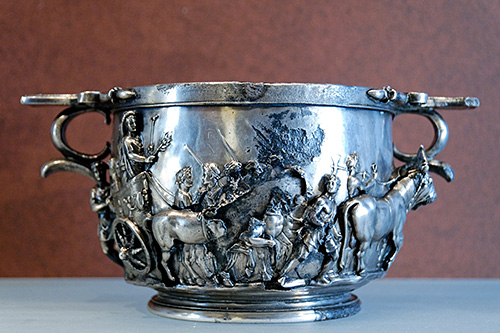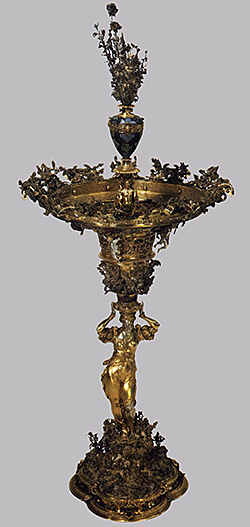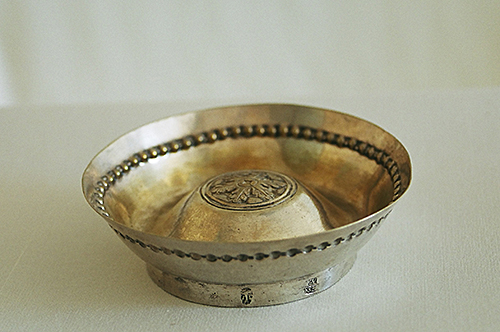19 October
lecture series
LAETIFICAT COR HOMINIS. WINE CULTURE IN NAVARRA
The art of silversmithing at the service of wine culture
Begoña Arrúe Ugarte
University of La Rioja
Throughout history, the culture of wine has provided artistic manifestations in all fields of art history. One of them is related to the goldsmiths' official document, both in the field of secular and religious commissions. The production is very diverse in the types of forms and techniques used, as well as in the variety of functions of the objects that served the developmentof viticulture. Examples of vessels and utensils related to the consumption of wine, made of bronze, silver and gold, are found from the third millennium BC. These materials obviously refer to their use by the wealthy social classes, or to a ceremonial and solemn or merely sumptuous purpose. Some designs have survived over time, regardless of the stylistic elements or motifs that characterise each period or civilisation, but others emerged with the advance of wine-making techniques and developed in modern and contemporary times, especially with the advances of industrialisation. Thus, alongside pieces of a high technical and functional level, used in the cellar or at laboratory, we can find others whose eminent artistic qualities were the main reason for their creation, with the goalof being exhibited for admiration.
The lecturehas followed a chronological speech, highlighting some of the types of objects that have characterised the art of silverware throughout the history of wine culture, trying to show them in relation to the images of their representation in painting and engraving. For example, in the civilisations of the Near East, the gold cup from the royal cemetery of Ur (2,600 BC; London, British Museum), the Egyptian silver vessels (1070 and 712 BC; New York, Metropolitan Museum of Art -MET-) or the horn with gazelle prothorax and Sassanid jug (4th and 6th-7th centuries; Washington D. C., Arthur M. Sackler Gallery) are worthy of special mention. From Classical Antiquity, from the 5th century BC to the 3rd c. AD, the Sassanid vessels have been preserved in national museums and museums in the USA and Europe. A wide variety of ceramic vessels related to wine, which were also made of silver, have been preserved in national and foreign museums from the 5th century BC to the 3rd century AD. These include wine-pouring jugs (oinochoe), cups (kylix), jugs and scyphs with handles for drinking wine, long-handled ladles for drawing wine from the psyqueter, which was filled with pure wine and placed in a crater of cold water or ice to cool it, cisterns for transferring wine mixed with water, and wine strainers. During the age of averageliterary or documentary sources are more abundant in information, although the study and conservation of these types of pieces is not, despite the greater frequency of their graphic representation in banqueting scenes or evangelical episodes such as the Wedding at Cana or the Dance of Salome. Although unique early medieval examples have been catalogued, the most significant objects correspond to the Christian liturgy with chalices carved in silver and gold, with agates, cabochons of precious stones and pearls, cameos or filigree work, which, from examples such as those of the monastery of Silos or San Isidoro de León (11th century), contributed to the ornamentation of the celebrations. In addition to ecclesiastical treasures, the progressive increase in private collecting during the Renaissance and Mannerist periods gave rise to precious objects that were displayed on the sideboards and tables of nobles and princes, such as the jugs and goblets made in workshops in Nuremberg or Antwerp, in which nautilus shells, ostrich eggs or coconut nuts were mounted in silver, painted or carved, and sculptural figures were cast with great creativity and technical richness. Some of these pieces would end up being donated to churches or monasteries and would be reused for liturgical purposes, such as the one preserved in the monastery of Santa María la Real de Fitero. Another significant piece was the cup with a high base and large bowl, with embossed scenes and free-standing figures, of which two examples are kept in the Museo Lázaro Galdiano (Madrid). There are also German becherns and French gobelets, as well as other types of vessels, such as chidus and wedding vessels, used in the blessing of wine(sheva berachot) in Jewish ceremonies.
Different types of pieces were developed from the late 17th and 18th centuries onwards, taking into account other factors related to the perfection of winemaking, the maintenance of its properties and temperature, as well as proper tasting and sampling. subjectThe silversmiths made and experimented with new types of funnels, pipettes and decanting siphons, as well as making decanters, coolers, cisterns, supports and all kinds of accessories for glass jugs or bottles, or decorating stoppers and creating silver labels to indicate the origin of the wine they contained. Although the spread of glass, as it did not alter the colour, smell or taste of the wine, led to the gradual replacement of silver in the serving of drinks, the art of silversmithing contributed a large number of bernegals, cups, glasses, goblets and wine glasses, each with specific models and characters depending on the place or workshop of origin. Likewise, it was not until the generalisation of cork for hermetically sealing the wine bottle that the mechanism for opening or uncorking it would appear. Silverware contributed to the infinite number of models and patents for corkscrews produced from the 17th century onwards, focusing especially on pocket corkscrews, whether folding, T-shaped or in the form of a T or multifunctional subject, with a steel spiral sheath, carved in silver and using other materials such as shell, mother-of-pearl or gold. In the same way that wine glasses were personalised with inscriptions and currency, corkscrews could be used to seal the sealing wax on bottles and identify their owners, by engraving arms or anagrams, or serve other purposes (whistle, magnifying glass, box, etc.). Various examples of these objects created in Great Britain, France, Germany and Holland were shown, of which unique examples can be found in the Vivanco collection of the Museum of Wine Culture (Briones, La Rioja).
Plates:

1. Scyphus, Boscoreale Treasure, late 1st c. BC-early 1st c. AD, silver, 9.40 x x .5 cm (Paris, Musée du Louvre) ©Marie-Lan Nguyen/Wikimedia Commons

2. Cup, Wenzel Jamnitzer, Nuremberg, 1549, gilded silver, 100 cm high (Amsterdam, Rijksmuseum).

3. Catavino, José, or Fermín, Gurrea, Santo Domingo de la Calzada (La Rioja), s. XVIII ex- s. XIX in, silver, 1 x .5 cm (Briones, La Rioja, Museum of Wine Culture).

4. Cistern, Charles Frederich Kandler (Elkungton & Co.) Birmingham, ca. 1880, electroplating, 100.3 x .1 x cm, 145.151 kg (New York, Metropolitan Museum of Art) © GFDL/Creative Commons
